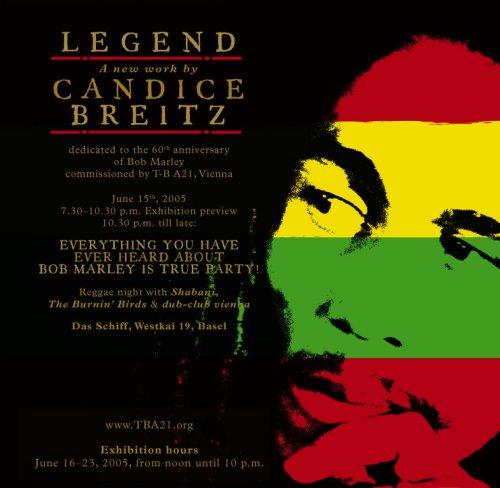Candice Breitz
dal 14/6/2005 al 20/6/2005
Segnalato da
Thyssen-Bornemisza Art Contemporary
14/6/2005
Candice Breitz
Das Schiff, Basel
Legend, 2005. A 30 channel video-installation that explores the contrasts between the Bob Marley who has become a brand name outside of Jamaica, and the Bob Marley, who was reverently described to her by Jamaicans on her first visit to the island. Having heard countless Jamaicans evoke the way in which Marley has affected their lives, the artist decided that it was time, 20 years after Legend was released, to 'return the album to Jamaica, in the same spirit that the Elgin marbles might one day be returned to Greece'.

Legend, 2005
A 30 channel video-installation
Commissioned by Thyssen-Bornemisza Art Contemporary
World premiere
Thyssen-Bornemisza Art Contemporary presents 'Legend', a new commission by South African artist Candice Breitz at Art Basel.
Candice Breitz’s thirty-channel installation Legend explores the contrasts between the Bob Marley who has become a brand name outside of Jamaica, and the Bob Marley, who was reverently described to her by Jamaicans on her first visit to the island. Legend was commissioned by Thyssen-Bornemisza Art Contemporary and shot during a residency in Port Antonio, Jamaica, in early 2005.
It was not until three years after Bob Marley’s premature death, with the release of the definitive
compilation album Legend in 1984, that his music first received the overwhelming international
support that it enjoys today. The posthumous collection of greatest hits quickly became the best-selling reggae album of all time, predicting in its title and confirming in its phenomenal sales, that Marley himself was on his way to becoming a legend. The commercial interests of Island Records played a significant role in the selection of songs for Legend. The militant aspects of Marley’s music were tempered by the presence of a generous range of memorable hooks and catchy melodies. Around the world, the dreadlocked image of Bob Marley has since become synonymous with reggae music and the island of Jamaica.
In his homeland, Marley has come to signify much more than Top Ten success. His ragsto-riches story, political conviction and Rastafarian belief have elevated him to the status of revolutionary prophet in Jamaica. In his music and in his life, Marley decried political injustice
and fought for social equality. It is this legacy that secures his continued popularity in Jamaica.
He remains emblematic amongst Jamaicans for having managed to transcend the violence and poverty of ghetto life through his music. To the many latent Marleys inhabiting the Trenchtowns of Jamaica, he is an inspiration and an example. In Jamaica, Marley is much more than a poster-boy for marijuana-enhanced island life: for as he created an image of himself, he also created a radical new image of themselves for his Jamaican supporters.
Having heard countless Jamaicans evoke the way in which Marley has affected their lives,
Breitz decided that it was time, twenty years after Legend was released, to ‘return the album
to Jamaica, in the same spirit that the Elgin marbles might one day be returned to Greece.’
Central to the reggae aesthetic, is the understanding that one original song, rhythm or melody,
can give rise to any number of equally innovative versions, covers or remixes. Breitz invited
thirty Jamaicans from all walks of life to sing their version of Legend in a professional recording
studio in Port Antonio, Jamaica. Each participant was invited to individually re-perform the
entire Legend album from beginning to end. The resulting thirty performances are screened
simultaneously on a wall of thirty monitors. Stubbornly insisting on the exact format of the
original fourteen-track album, as if to acknowledge the undeniable role that marketing has
played in the packaging of the Marley myth, Breitz’s Legend strips away the voice of Marley
and the familiar musical arrangements, so that ultimately Marley remains present in the work
only through the voices of his fans. The work thus invites us to imagine a charismatic cultural
icon not as a monolithic and isolated figure, but rather as a complex composite of those
whose stories he has told and those whose lives continue to be inflected through his music.
In the year that Bob Marley would have been sixty, Legend recognizes his continuing impact
on Jamaican culture, but also considers the complex and delicate machinery of fan worship
that generates every legend: the resulting installation is an a cappella portrait of the man who
remains remarkable for having become the first Third World superstar.
The Songs:
1. Is This Love / 2. No Woman No Cry / 3. Could You Be Loved / 4. Three Little Birds / 5. Buffalo Soldier / 6. Get Up Stand Up / 7. Stir It Up / 8. One Love / People Get Ready / 9. I Shot The Sheriff / 10. Waiting in Vain / 11. Redemption Song / 12. Satisfy My Soul / 13. Exodus / 14. Jamming
Information:
Thyssen-Bornemisza Art Contemporary
Himmelpfortgasse 13, A-1010 Wien
T +43 1 513 98 56
F +43 1 513 98 56 22
Press / T-B A21
Christina Werner
w.hoch.zwei. Kulturelles Projektmanagement
Breite Gasse 17/4, A-1070 Wien
T +43 1 524 96 46 DW 22
F +43 1 524 96 32
E-Mail werner@kunstnet.at
Opening: June 15, 2005, 7 PM
Das Schiff, Westquai 19, Hafen Basel
Open daily from 12 to 10 PM



